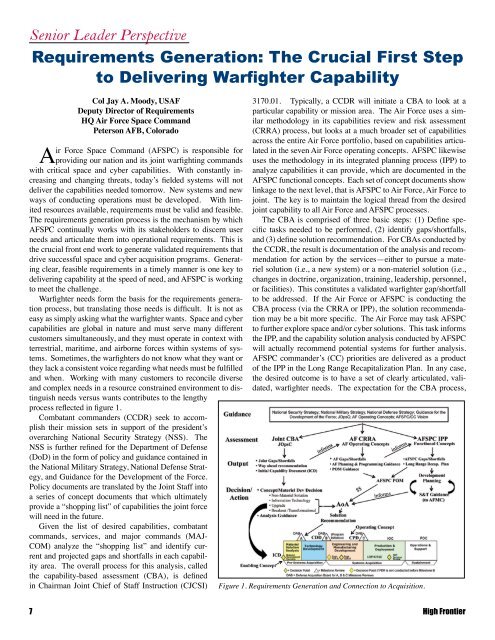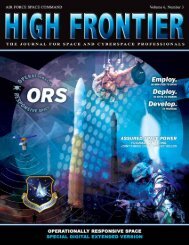Space Acquisition - Air Force Space Command
Space Acquisition - Air Force Space Command
Space Acquisition - Air Force Space Command
You also want an ePaper? Increase the reach of your titles
YUMPU automatically turns print PDFs into web optimized ePapers that Google loves.
Senior Leader Perspective<br />
Requirements Generation: The Crucial First Step<br />
to Delivering Warfighter Capability<br />
Col Jay A. Moody, USAF<br />
Deputy Director of Requirements<br />
HQ <strong>Air</strong> <strong>Force</strong> <strong>Space</strong> <strong>Command</strong><br />
Peterson AFB, Colorado<br />
<strong>Air</strong> <strong>Force</strong> <strong>Space</strong> <strong>Command</strong> (AFSPC) is responsible for<br />
providing our nation and its joint warfighting commands<br />
with critical space and cyber capabilities. With constantly increasing<br />
and changing threats, today’s fielded systems will not<br />
deliver the capabilities needed tomorrow. New systems and new<br />
ways of conducting operations must be developed. With limited<br />
resources available, requirements must be valid and feasible.<br />
The requirements generation process is the mechanism by which<br />
AFSPC continually works with its stakeholders to discern user<br />
needs and articulate them into operational requirements. This is<br />
the crucial front end work to generate validated requirements that<br />
drive successful space and cyber acquisition programs. Generating<br />
clear, feasible requirements in a timely manner is one key to<br />
delivering capability at the speed of need, and AFSPC is working<br />
to meet the challenge.<br />
Warfighter needs form the basis for the requirements generation<br />
process, but translating those needs is difficult. It is not as<br />
easy as simply asking what the warfighter wants. <strong>Space</strong> and cyber<br />
capabilities are global in nature and must serve many different<br />
customers simultaneously, and they must operate in context with<br />
terrestrial, maritime, and airborne forces within systems of systems.<br />
Sometimes, the warfighters do not know what they want or<br />
they lack a consistent voice regarding what needs must be fulfilled<br />
and when. Working with many customers to reconcile diverse<br />
and complex needs in a resource constrained environment to distinguish<br />
needs versus wants contributes to the lengthy<br />
process reflected in figure 1.<br />
Combatant commanders (CCDR) seek to accomplish<br />
their mission sets in support of the president’s<br />
overarching National Security Strategy (NSS). The<br />
NSS is further refined for the Department of Defense<br />
(DoD) in the form of policy and guidance contained in<br />
the National Military Strategy, National Defense Strategy,<br />
and Guidance for the Development of the <strong>Force</strong>.<br />
Policy documents are translated by the Joint Staff into<br />
a series of concept documents that which ultimately<br />
provide a “shopping list” of capabilities the joint force<br />
will need in the future.<br />
Given the list of desired capabilities, combatant<br />
commands, services, and major commands (MAJ-<br />
COM) analyze the “shopping list” and identify current<br />
and projected gaps and shortfalls in each capability<br />
area. The overall process for this analysis, called<br />
the capability-based assessment (CBA), is defined<br />
in Chairman Joint Chief of Staff Instruction (CJCSI)<br />
3170.01. Typically, a CCDR will initiate a CBA to look at a<br />
particular capability or mission area. The <strong>Air</strong> <strong>Force</strong> uses a similar<br />
methodology in its capabilities review and risk assessment<br />
(CRRA) process, but looks at a much broader set of capabilities<br />
across the entire <strong>Air</strong> <strong>Force</strong> portfolio, based on capabilities articulated<br />
in the seven <strong>Air</strong> <strong>Force</strong> operating concepts. AFSPC likewise<br />
uses the methodology in its integrated planning process (IPP) to<br />
analyze capabilities it can provide, which are documented in the<br />
AFSPC functional concepts. Each set of concept documents show<br />
linkage to the next level, that is AFSPC to <strong>Air</strong> <strong>Force</strong>, <strong>Air</strong> <strong>Force</strong> to<br />
joint. The key is to maintain the logical thread from the desired<br />
joint capability to all <strong>Air</strong> <strong>Force</strong> and AFSPC processes.<br />
The CBA is comprised of three basic steps: (1) Define specific<br />
tasks needed to be performed, (2) identify gaps/shortfalls,<br />
and (3) define solution recommendation. For CBAs conducted by<br />
the CCDR, the result is documentation of the analysis and recommendation<br />
for action by the services—either to pursue a materiel<br />
solution (i.e., a new system) or a non-materiel solution (i.e.,<br />
changes in doctrine, organization, training, leadership, personnel,<br />
or facilities). This constitutes a validated warfighter gap/shortfall<br />
to be addressed. If the <strong>Air</strong> <strong>Force</strong> or AFSPC is conducting the<br />
CBA process (via the CRRA or IPP), the solution recommendation<br />
may be a bit more specific. The <strong>Air</strong> <strong>Force</strong> may task AFSPC<br />
to further explore space and/or cyber solutions. This task informs<br />
the IPP, and the capability solution analysis conducted by AFSPC<br />
will actually recommend potential systems for further analysis.<br />
AFSPC commander’s (CC) priorities are delivered as a product<br />
of the IPP in the Long Range Recapitalization Plan. In any case,<br />
the desired outcome is to have a set of clearly articulated, validated,<br />
warfighter needs. The expectation for the CBA process,<br />
Figure 1. Requirements Generation and Connection to <strong>Acquisition</strong>.<br />
7 High Frontier











